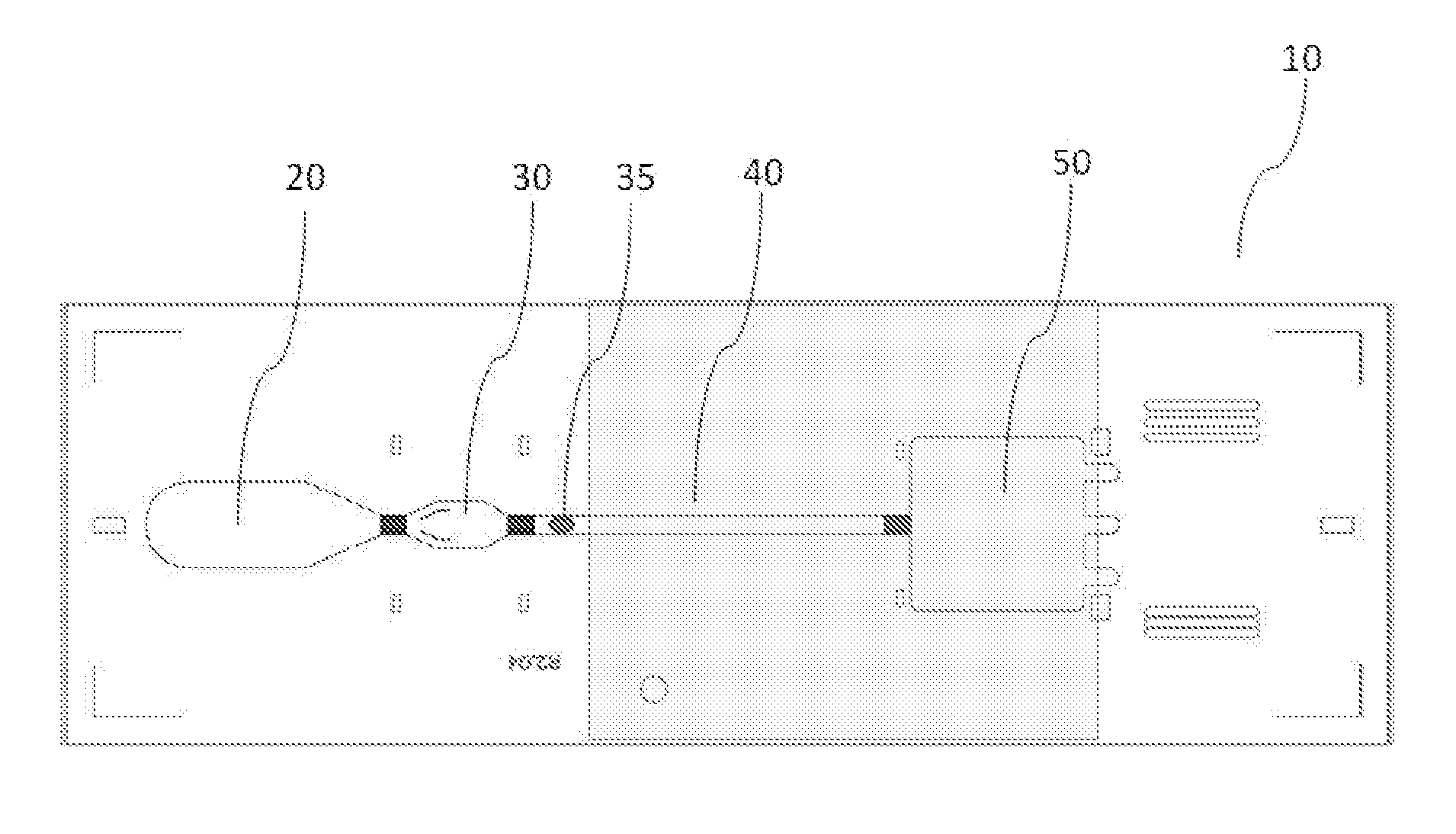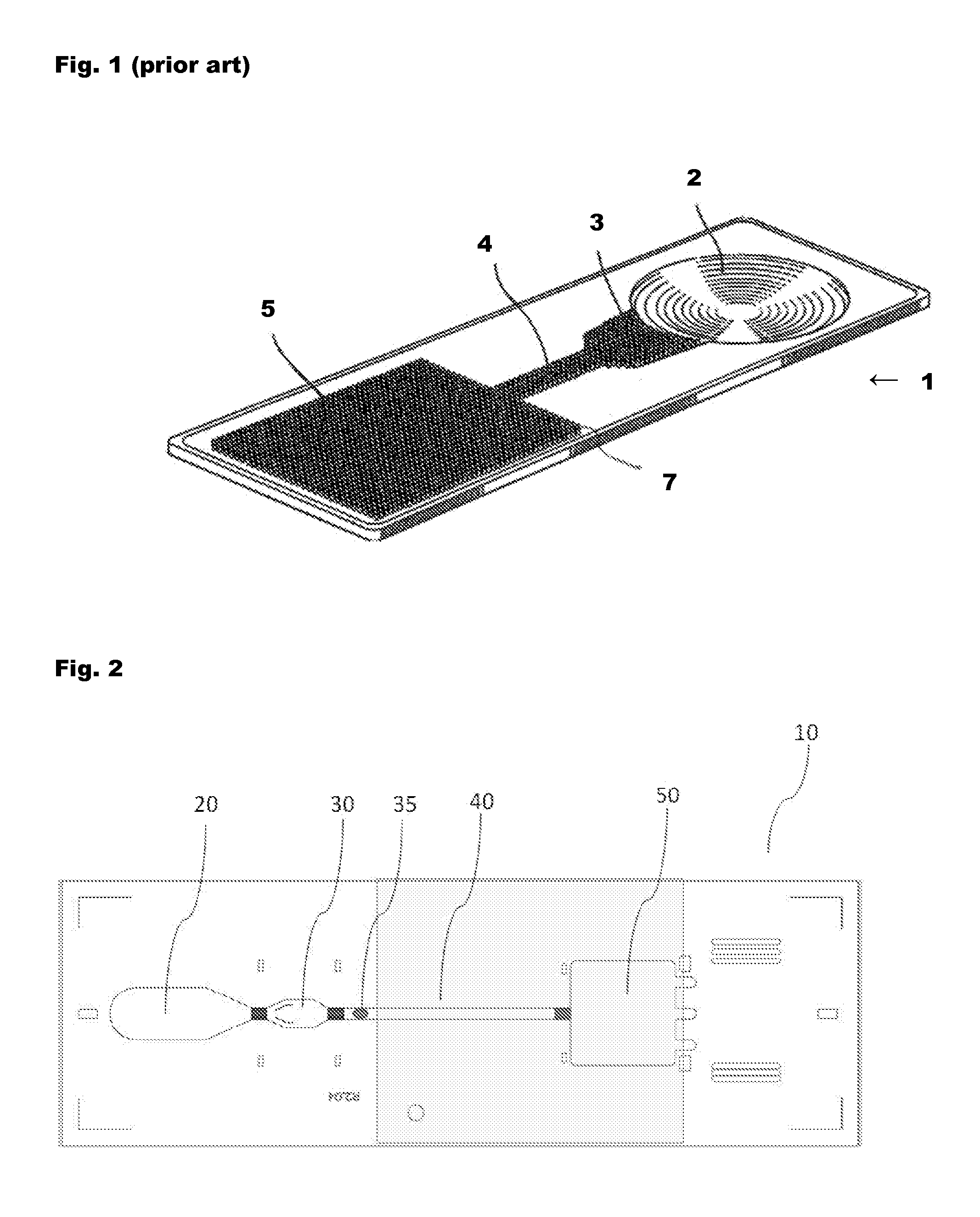Assay Device Having Controllable Sample Size
- Summary
- Abstract
- Description
- Claims
- Application Information
AI Technical Summary
Benefits of technology
Problems solved by technology
Method used
Image
Examples
example 1
[0071]Plastic substrate chips made of Zeonor (Zeon, Japan) having oxidized dextran on the surface for covalent immobilization of proteins via Schiff base coupling were used. For NTproBNP chips, fluorescently labeled Anti-NT-proBNP monoclonal antibody was deposited and dried to create a reagent zone. Anti-NT-proBNP monoclonal antibody was deposited and dried to create a detection zone. A small amount of Triton X-45 was deposited on the device to increase wettability of the sample for better capillary flow. Sample was added to the sample zone of the device and the capillary action of the micropillar array distributed the sample through the flow channel into the wicking zone. A typical assay time was about 10 minutes. The signal intensities from the fluorescently labeled complexes in the detection zone were recorded in a prototype line-illuminating fluorescence scanner. For carbamazepine chips, the carbamazepine detection reagent was prepared by covalently linking a carbamazepine hapte...
example 2
[0092]Assay devices made of Zeonor (Zeon, Japan) having oxidized dextran on the surface for covalent immobilization of proteins via Schiff base coupling were used. Fluorescently labeled Anti-NT-proBNP monoclonal antibody was deposited and dried to create a reagent zone. Anti-NT-proBNP monoclonal antibody was deposited and dried to create a detection zone. A small amount of Triton X-45 was deposited on the device to increase wettability of the sample for better capillary flow. Serum spiked with NT-proBNP was added to the sample zone of the device and the capillary action of the micropillar array distributed the sample through the flow channel into the wicking zone. Sample volumes of 15 microliters were employed on low-volume device designs R2.02, R2.04, R2.09 and R3.16. The R1.02 device design was a control device, intended for use with 200 microliters of whole blood, such as shown in FIG. 1. R1.02 devices were tested in this example with 45 microliters of serum. A typical assay time...
example 3
[0094]Miniaturized assay devices having dual reagent cells made of Zeonor (Zeon, Japan) having oxidized dextran on the surface for covalent immobilization of proteins via Schiff base coupling were used. Fluorescently labeled anti-procalcitonin monoclonal antibody was deposited and dried to create a reagent zone. Anti-procalcitonin monoclonal antibody was deposited and dried to create a detection zone. A small amount of Triton X-45 was deposited on the device to increase wettability of the sample for better capillary flow. In this example, 25 microliters of whole blood containing procalcitonin was applied to a filter in contact with the sample addition zone of the assay device. Plasma is transferred from the filter into the sample addition zone and then moves by capillary force through the flow path to the wicking zone. The fluid flow was monitored by visual inspection and 10 microliters of a wash fluid containing 0.01 M phosphate buffer, 0.0027 M potassium chloride, 0.137 M sodium c...
PUM
 Login to View More
Login to View More Abstract
Description
Claims
Application Information
 Login to View More
Login to View More - R&D Engineer
- R&D Manager
- IP Professional
- Industry Leading Data Capabilities
- Powerful AI technology
- Patent DNA Extraction
Browse by: Latest US Patents, China's latest patents, Technical Efficacy Thesaurus, Application Domain, Technology Topic, Popular Technical Reports.
© 2024 PatSnap. All rights reserved.Legal|Privacy policy|Modern Slavery Act Transparency Statement|Sitemap|About US| Contact US: help@patsnap.com










